Hemmoroids
Surgery for haemorrhoids (piles)
Surgery may be recommended if other treatments for haemorrhoids (piles) haven't worked, or if you have haemorrhoids that aren't suitable for non-surgical treatment.
There are many different surgical procedures for piles. The main types of operation are described below.
Haemorrhoidectomy
A haemorrhoidectomy is an operation to remove haemorrhoids. It's usually carried out undergeneral anaesthetic, which means you'll be unconscious during the procedure and won't feel any pain while it's carried out. A conventional haemorrhoidectomy involves gently opening the anus so the haemorrhoids can be cut out. You'll need to take a week or so off work to recover. You'll probably experience significant pain after the operation, but you will be given painkillers. You may still have pain a few weeks after the procedure, which can also be controlled with painkillers. Seek medical advice if you have pain that continues for longer. After having a haemorrhoidectomy, there's around a 1 in 20 chance of the haemorrhoids returning, which is lower than with non-surgical treatments. Adopting or continuing a high-fibre diet after surgery is recommended to reduce this risk.
Haemorrhoidal artery ligation
Haemorrhoidal artery ligation is an operation to reduce the bloodflow to your haemorrhoids. It's usually carried out under general anaesthetic and involves inserting a small ultrasound probe into your anus. The probe produces high-frequency sound waves that allow the surgeon to locate the vessels supplying blood to the haemorrhoid. Each blood vessel is stitched closed to block the blood supply to the haemorrhoid, which causes it to shrink over the following days and weeks. The stitches can also be used to reduce haemorrhoids that hang down from the anus (prolapsing). The National Institute for Health and Care Excellence (NICE) recommends haemorrhoidal artery ligation as a safe and effective alternative to a haemorrhoidectomy or stapled haemorrhoidopexy. It causes less pain and, in terms of results, a high level of satisfaction has been reported. The recovery time after having haemorrhoidal artery ligation is also quicker compared with other surgical procedures. There's a low risk of bleeding, pain when passing stools, or the haemorrhoid becoming prolapsed after this procedure, but these usually improve within a few weeks.
Stapled hemmoroidopexy
What is stapled hemorrhoidectomy?
Stapled hemorrhoidectomy is surgical technique for treating hemorrhoids, and is the treatment of choice for third-degree hemorrhoids (hemorrhoids that protrude with straining and can be seen on physical exam outside the anal verge. Persistent or intermittent manual reduction is necessary). Stapled hemorrhoidectomy is a misnomer since the surgery does not remove the hemorrhoids but, rather, the abnormally lax and expanded hemorrhoidal supporting tissue that has allowed the hemorrhoids to prolapse downward.
For stapled hemorrhoidectomy, a circular, hollow tube is inserted into the anal canal. Through this tube, a suture (a long thread) is placed, actually woven, circumferentially within the anal canal above the internal hemorrhoids. The ends of the suture are brought out of the anus through the hollow tube. The stapler (a disposable instrument with a circular stapling device at the end) is placed through the first hollow tube and the ends of the suture are pulled. Pulling the suture pulls the expanded hemorrhoidal supporting tissue into the jaws of the stapler. The hemorrhoidal cushions are pulled back up into their normal position within the anal canal. The stapler then is fired. When it fires, the stapler cuts off the circumferential ring of expanded hemorrhoidal tissue trapped within the stapler and at the same time staples together the upper and lower edges of the cut tissue.
Who is a good candidate for stapled hemorrhoidectomy?
Stapled hemorrhoidectomy, although it can be used to treat second degree hemorrhoids (hemorrhoids that extend outside the anus after a bowel movement or straining, but return inside by themselves), usually is reserved for higher grades of hemorrhoids - third and fourth degree. Third degree hemorrhoids can be pushed back into the anus with a finger after a bowel movement. Fourth degree hemorrhoids are always outside. If in addition to internal hemorrhoids there are small external hemorrhoids that are causing a problem, the external hemorrhoids may become less problematic after the stapled hemorrhoidectomy. Another alternative is to do a stapled hemorrhoidectomy and a simple excision of the external hemorrhoids. If the external hemorrhoids are large, a standard surgical hemorrhoidectomy may need to be done to remove both the internal and external hemorrhoids.
Quick GuideHow to Get Rid of Hemorrhoids: Causes and Treatments

Pictures of stapled hemorrhoidectomy procedure
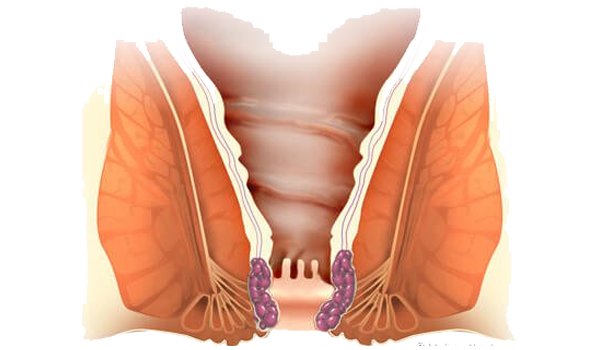
Picture of Internal Hemorrhoids in Anal Canal
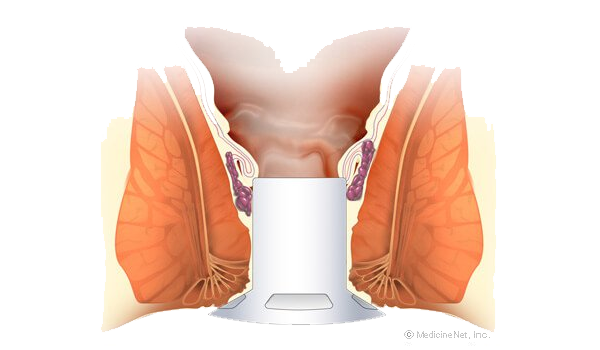
Picture of Hollow Tube Inserted into the Anal Canal and Pushing up the Hemorrhoids
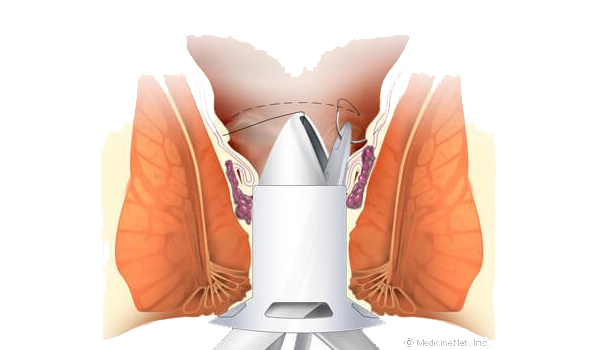
Picture of Suturing the Anal Canal through the Hollow Tube
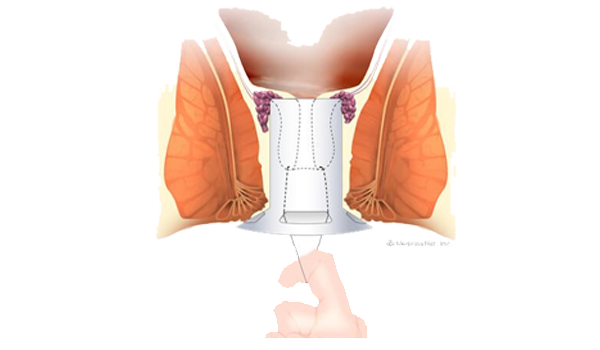
Picture of Bringing Expanded Hemorrhoidal Supporting Tissue into the Hollow Tube by pulling On Suture
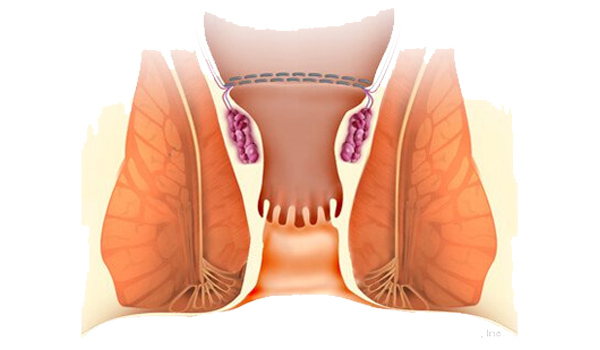
Picture of Hemorrhoids Pulled Back Above Anal Canal after Stapling and Removal of Hemorrhoidal Supporting Tissue
What happens to the staples from a stapled hemorrhoidectomy?
During stapled hemorrhoidectomy, the arterial blood vessels that travel within the expanded hemorrhoidal tissue and feed the hemorrhoidal vessels are cut, thereby reducing the blood flow to the hemorrhoidal vessels and reducing the size of the hemorrhoids. During the healing of the cut tissues around the staples, scar tissue forms, and this scar tissue anchors the hemorrhoidal cushions in their normal position higher in the anal canal. The staples are needed only until the tissue heals. After several weeks, they then fall off and pass in the stool unnoticed. Stapled hemorrhoidectomy is designed primarily to treat internal hemorrhoids, but if external hemorrhoids are present, they may be reduced as well.
How long does stapled hemorrhoidectomy take?
Stapled hemorrhoidectomy is faster than traditional hemorrhoidectomy, taking approximately 30 minutes. It is associated with much less pain than traditional hemorrhoidectomy and patients usually return earlier to work. Patients often sense a fullness or pressure within the rectum as if they need to defecate, but this usually resolves within several days. The risks of stapled hemorrhoidectomy include bleeding, infection, anal fissuring (tearing of the lining of the anal canal), narrowing of the anal or rectal wall due to scarring, persistence of internal or external hemorrhoids, and, rarely,trauma to the rectal wall.
Stapled hemorrhoidectomy may be used to treat patients who have both internal and external hemorrhoids; however, it also is an option to combine a stapled hemorrhoidectomy to treat the internal hemorrhoids and a simple resection of the external hemorrhoids.